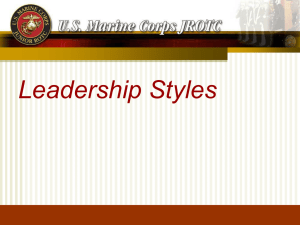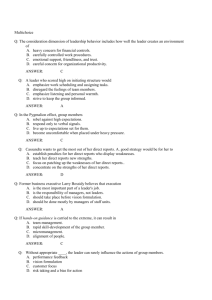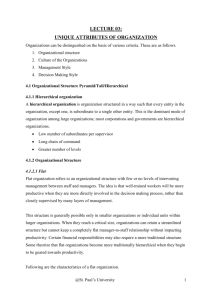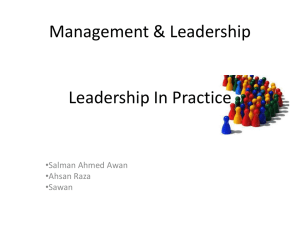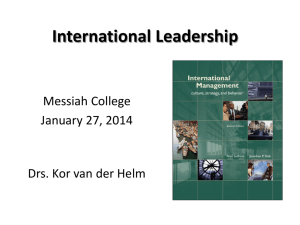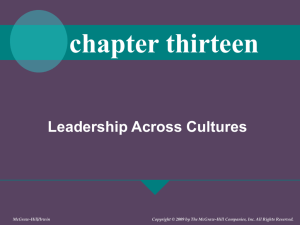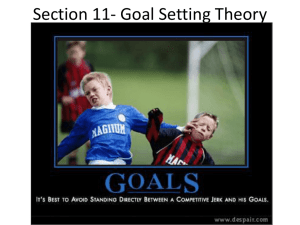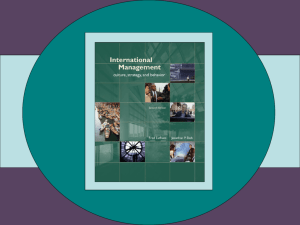Leadership and Motivation
advertisement
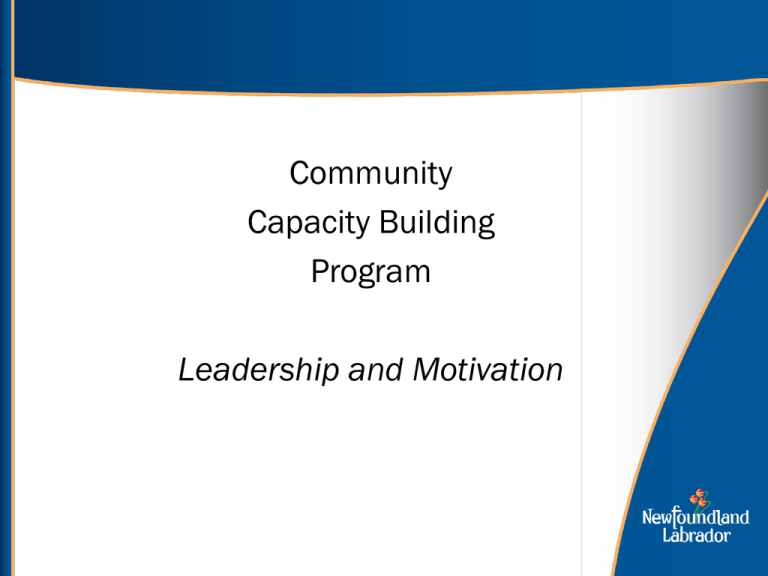
Community Capacity Building Program Leadership and Motivation Learning Objectives • Understanding the relationship between leadership and motivation • Motivation through a psychological framework • Leadership theories/styles • Participative leadership • Qualities of successful leaders Introduction 2 major influences affect how individuals perform: 1. The type of leadership that exists 2. Personal motivation • Important to look at these two concepts as interconnected and dependent on individual situations What is motivation? • Motivation is defined as “the extent to which persistent effort is directed toward a goal” 1. Effort - must be defined in relation to its appropriateness to the objectives being pursued. 2. Persistence - relates to the willingness of the individual to stay with a task until it is complete 3. Direction - measured in terms of how persistent effort is applied in relation to the goals being pursued 4. Goals - individual goals and organizational goals (must be compatible) Types of motivation • Extrinsic Motivation - Factors in the external environment such as pay, supervision, benefits, and job perks • Intrinsic Motivation - Relationship between the worker and the task 5 Ways to Motivate a Team 1. Figure out what makes them tick (individual needs) 2. Give clear expectations 3. Consistent reinforcement and consequences 4. Healthy competition 5. Change out team members Activity 1 – Identifying Goals • Create a thought web linking current and future goals of the organization to internal or external motivators • Example: Goal: Increase sales by 10% Motivators: Top seller receives financial bonus if goal is reached (extrinsic) Top seller gets to choose their next project (allowing seller to pursue work-based interest would increase intrinsic motivation) Needs-based Motivation • Maslow’s Hierarchy of Needs: Physiological Safety Relationship Esteem Self-actualization • The more you move from basic to higher level needs, the more motivation depends on internal factors • Important that organizations present opportunities to satisfy such needs Needs-based Motivation • Alderfer’s ERG Theory: Existence Relatedness Growth • Similar to Maslow’s Hierarchy in that it focuses on a differing levels of needs, which are usually satisfied in order of importance • Unlike Maslow’s theory in that it allows for higher needs to be met before lower-level needs under certain circumstances Needs-based Motivation • McClelland’s Theory of Needs: Achievement Affiliation Power • Concerned with the behavioral consequences of need • Non-hierarchical Needs-based Motivation • These three theories present a useful approach for thinking about organizational behavior • One is not inherently better than the other; The point is to apply the concepts of internal/external motivation to individual situations Motivational Goals Most goals fall within two categories: • Performance goal - individual is concerned with acquiring favorable judgment from his or her peers, supervisors, or authority figures (extrinsic) • Learning goal - individual uses feedback to increase his or her competence (intrinsic) Activity 2 – Needs and Motivation • In small groups, answer the following questions: 1. Whose needs are satisfied through my organization? (Owners, employees, clients, etc.) 2. What are some needs of each group? (Relatedness? Achievement?) 3. What is the best way to address those needs to reach goals? Leadership • Once it is known what motivates people, leadership can be thought of in relation to individual situations • Two main types of leaders: Emergent Assigned Leadership – Shaping Behavior • Rewards – the most effective type of reinforcement E.g. Compliments, tangible benefits, etc. • Punishments – have minimal impact on behaviour E.g. Reprimands, withholding of raises, unfavorable task assignments, etc. Leadership Styles • Directive - includes scheduling work, maintaining performance standards, and letting subordinates know what is expected from them • Supportive - friendly, approachable, and concerned with pleasant interpersonal relationships. • Participative – leaders will consult with their subordinates, and consider their opinions. • Achievement-oriented - encourages subordinates to exert higher efforts and strive for a higher level of goal accomplishment. Situational Factors • 2 major situational factors affecting leader success: Subordinate Characteristics – aptitude, individual needs Environmental factors – task urgency, clarity, appropriateness of leader’s style to the situation, timing Participative Leadership • Has a wide range of applications – Can have total involvement of subordinates in implementation, planning, etc. • Possible benefits of participation: Motivation Quality Acceptance • Possible Pitfalls Requires a lot of time and energy Resentment • Best to use this style when employees are part of a team for an extended period and are knowledgeable/proficient Leadership Styles • Vroom and Jago’s styles: Autocratic Consultative Group Qualities of Successful Leaders • Intellectual Stimulation • Energy • Self-confidence • Assertiveness • Dominance • Motivation • Honesty and Integrity • Charisma Final Activity – Leadership Considerations • Through other activities, goals, needs, and possible motivators were identified. Now, take time in groups to discuss the best leadership style for one’s own situation. • Questions to consider: How involved do others need or want to be? Is participative leadership an option? Why or why not? What environmental considerations are there? Are there external influences? Is it possible to adapt your leadership style to different situations? Give examples Participants’ Input STRATEGY & PLANNING RELATIONSHIP BUILDING ORGANIZATIONAL SKILLS & MANAGEMENT CO-OPERATIVE DEVELOPMENT Strategic Planning Community Development Organizational Governance Basics of a Co-operative Proposal Writing Public Participation Board Orientation Co-operatives and the Community Development Process I Project Management Alternative Dispute Resolution Meeting Management Co-operative and the Community Development Process II Opportunity Identification Group Dynamics Leadership and Motivation Opportunity Management Interpersonal Communications Communications Planning Legal Issues Conclusion and Evaluation • • • • • • Review objectives Review any additional expectations Review Parking Lot Point out Certificates of Participation Complete evaluation Thank you! Community Capacity Building Program http://www.ibrd.gov.nl.ca/regionaldev/capacitybuilding.html
